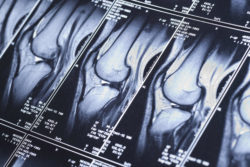 A knee replacement is a solution for many patients whose knees have worn out, but knee replacements can come with problems of their own. Many patients may not anticipate experiencing pain years after a knee replacement, but a number of conditions can cause it to occur, including aseptic loosening.
A knee replacement is a solution for many patients whose knees have worn out, but knee replacements can come with problems of their own. Many patients may not anticipate experiencing pain years after a knee replacement, but a number of conditions can cause it to occur, including aseptic loosening.
What Can Cause Pain Years After Knee Replacement?
Around 10 percent of knee replacement patients are less than satisfied with the results of their knee replacement surgery. Some report pain that can come from postoperative infection or a bone fracture around the replacement, or persistent pain around a new knee replacement.
Problems that persist years after a knee replacement include a loss of mobility or range of motion, instability, chronic pain, or loosening of the knee implant.
A knee replacement won’t give patients the full strength and flexibility of a healthy, natural knee, but a knee replacement should allow patents to engage in many activities they couldn’t participate in before the surgery. Persistent pain many years after a knee replacement can prohibit this from being possible.
Causes of pain after a knee replacement may not be evident to a patient, but a medical professional should be able to take several steps to help you understand why you are in pain, and can help you do something about it.
Aseptic Loosening
When the implant loosens but does not become infected, this condition is called aseptic loosening. This can occur because the bond between the natural bone and the knee replacement has become compromised. In knee replacements in which bone cement is used to secure the implant to the natural bone, aseptic loosening can be caused by the bone cement failing.
Aseptic loosening is more common in the part of the implant that’s attached to a patient’s tibia bone. It’s less common in the femur component.
Other Conditions Can Cause Pain Years After a Knee Replacement
Alignment problems: If a knee implant is not installed in a patient’s body correctly, the device may not function properly, and can cause persistent pain, even years after a knee replacement surgery. A proper alignment can reportedly make more of a difference in performance than the type of implant used in a knee replacement surgery.
Kneecap problems: Similar to alignment problems, how a kneecap is put in during a knee replacement surgery has to do with the surgeon, and can have a great effect on performance. Kneecap problems are a common source of pain after a knee replacement.
Knees are a complicated joint, and significant force is put on kneecaps during normal activities like standing up or walking down stairs. Making sure a kneecap works well with a knee replacement can be a tricky procedure, even for talented surgeons.
Pinched nerves: A knee replacement surgery is a complicated procedure, which can cause serves to be injured or pinched. A “pinched nerve” is a non-medical term used to describe a situation when pressure is put on a nerve. This can result from a knee replacement surgery and can cause pain.
If you or a loved one underwent revision knee replacement surgery or your doctor is recommending revision surgery three years or less after the initial implant and a bone cement was used, you may qualify to file a knee replacement revision surgery lawsuit. See if you qualify by filling out the free form on this page.
ATTORNEY ADVERTISING
Top Class Actions is a Proud Member of the American Bar Association
LEGAL INFORMATION IS NOT LEGAL ADVICE
Top Class Actions Legal Statement
©2008 – 2026 Top Class Actions® LLC
Various Trademarks held by their respective owners
This website is not intended for viewing or usage by European Union citizens.
Get Help – It’s Free
Join a Free Knee Replacement Cement Failure Lawsuit Investigation
If you qualify, an attorney will contact you to discuss the details of your potential case at no charge to you.
PLEASE NOTE: If you want to participate in this investigation, it is imperative that you reply to the law firm if they call or email you. Failing to do so may result in you not getting signed up as a client or getting you dropped as a client.
Oops! We could not locate your form.












